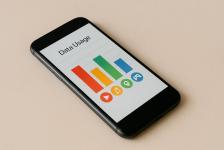Phishing attacks often appear credible and convincing today. Thanks to artificial intelligence, they sound personal, mimic well-known companies, and can be hard to detect. In this article, you'll learn how modern phishing works, why you should watch out for it, and how you can effectively protect yourself from it.

A message arrives. It looks serious, stating that you have an account issue, and at the end, they ask you to verify your password. Everything seems authentic – and that's the problem. Phishing attacks have undergone a quiet transformation: they are no longer laughable but need stopping. Thanks to artificial intelligence, scammers can write like a real bank, business, or colleague from work. And they can hit the tone, language, and situation you really are in.
Whereas before, you could recognize a scam by poor language or a suspicious address, today, small details make the difference. An unexpected call to action, a changed style of communication, subtle redirection. Phishing is now more precise, smarter, and significantly harder to recognize than ever before.
In this article, we'll show you how modern phishing works, why to be cautious, and how to effectively defend yourself – whether you're a savvy user or a beginner on the internet who doesn't want to fall for it.
What is phishing and why do people still fall for it?
Phishing is a form of fraud that seeks to extract sensitive information from a user – such as login names, passwords, or payment information. It most commonly comes via email but increasingly appears in SMS messages, on social media, or in chat applications. The attacker usually poses as a trusted organization or person to create a sense of legitimacy and prompt a quick response.
Even though phishing has been talked about for years, it still works. Why? Because it targets human emotions – fear, trust, curiosity, or even routine inattentiveness. And because it masquerades as something familiar. Often, it involves messages warning that an account is expiring, that suspicious access was noted, or that something needs quick confirmation. Attackers rely on you not paying attention in haste and daily hustle.
AI helps attackers be more convincing
The advent of generative artificial intelligence has significantly simplified the creation of phishing messages, which appear as legitimate corporate communication. Today, scammers use tools like ChatGPT, Gemini, or Claude to generate text without grammatical errors, in natural language, and with a tone that meets the recipient's expectations.
By combining AI outputs with data from social networks, publicly available databases, or leaked email templates, attackers can create highly personalized messages. The recipient thus receives an email that raises no suspicion. Given the context and style, it resembles routine communication that they're accustomed to.
Advanced techniques also include the use of AI for translations without signs of machine translation, simulation of corporate brand voice, or generation of credible visual elements, including fake login pages. Phishing is thus moving from amateur scams to professionally prepared attacks requiring a higher degree of vigilance.

How to tell something is wrong?
Phishing messages look trustworthy at first glance today, but there are still signs by which you can detect them. These are not glaring mistakes but rather subtle inconsistencies. When you know what to look for, it's easier to become alert in time.
Pressure for quick response
Phishing often creates an artificial sense of urgency. Messages claim that if you don't act immediately – for example, confirm a payment or change a password – you'll lose the account, money, or access to a service. The goal is to get you to act without thinking. Serious institutions usually allow time for verification and don't use coercive methods.
Unexpected message with no prior context
If a bank, carrier, or online store contacts you with no prior reason, for example that a package couldn't be delivered or that access has been suspended, be cautious. Attackers bet on the possibility of such situations happening at any time, making the message sound believable.
Suspicious email address or domain
The sender's address might seem okay at first glance but often contains slight differences: swapped characters, a different suffix, or a completely different domain masked by a well-known company name. Look closely, even a small deviation can mean a scam.
Hidden or misleading link
Hyperlinks might look credible but lead to a fraudulent page. On a computer, hover over them with your mouse to see where they actually go. On a mobile, press and hold to check the address. If something seems off – like a missing domain name or if it is overly long and complex – don't click.
Unusual tone, format, or language
The message might be too formal or, conversely, too casual, with unusual phrases, confusing formatting, or a style that the company doesn't usually use. If you're used to receiving emails in a certain format, any deviation should alert you.
How to protect yourself in 2025?
The good news is that you're not defenseless against phishing. Besides basic caution, there are specific tools and procedures that can protect you in 2025 better than ever before.
1. Use two-factor authentication (2FA)
Even if someone gets your password, they can't access your account without the second step of authentication through a mobile app or hardware key. The safest option is called passkey or biometric authentication through a device.
2. Use password managers
Password managers not only generate strong and unique passwords but also often recognize suspicious sites. If your manager doesn't offer automatic filling, it's a signal the site might not be trustworthy.
3. Monitor your account activity
Most email and banking services allow you to view login history and unusual accesses. Regular checking can help you detect breaches in time.
4. Update software and devices
Phishing often targets unsecured systems. Older versions of operating systems, browsers, or email clients may contain vulnerabilities that have already been fixed – but not for you if you don't update.
5. Use email filters and spam protection
Modern email services have advanced algorithms that detect phishing attempts based on sender behavior, reputation, and content. Make sure they are turned on and up to date.
6. Educate yourself and follow the trends
Attackers are constantly changing their techniques. Follow current scam campaigns, for example through bank sites, email providers, or national security authorities.
Trust but verify
Phishing in the era of artificial intelligence isn't about glaring mistakes anymore but about details noticeable only to those who know to be cautious. Emails that look normal, links that seem credible, and names you know.
Digital trust should never be blind. Even if you know the service or sender, verify. Stop. Click only when you are sure. Because cybersecurity is not a matter of technology, but of everyday behavior.
Chips under the skin and in the head. The future is closer than we think

Brain microchips already allow controlling a computer with mere thoughts. In the article, you will learn how they work, what they have brought to the first users, and what promises scientists and Elon Musk associate with them. Along with hopes, questions about safety, ethics, and where this technology might take us also arise.
What consumes the most data on mobile? YouTube, Spotify, Netflix and other apps under scrutiny

Mobile data usage can sometimes be unpleasantly surprising. The most are consumed by video streaming and music services – how much data does YouTube, Netflix or Spotify use? And what about other apps like social networks, maps or video calls? Check out the overview of the biggest data guzzlers and find out how to keep mobile data under control.
How to find out who is connected to your Wi-Fi – and can you easily disconnect them?

Is your internet slowing down or do you suspect that someone unauthorized is connected to your Wi-Fi? We advise you on how to find out who is connected to your Wi-Fi, and what to do if you find an intruder.
Artificial intelligence is not omnipotent. Where does the human still have the advantage?

Artificial intelligence can write articles, analyze data, and generate videos. However, there are skills and professions that this technology cannot (yet) replace. In the article, we will look at where humans still have the upper hand, why AI needs human supervision, and which abilities will become increasingly valuable to develop in the digital world.
What internet speed is sufficient? Comparison for streaming, gaming, work, and TV

Does your video keep buffering or game lag, even though you pay for 'fast internet'? Perhaps you simply don't have the right one for what you do at home. What internet speed do you need for watching TV, streaming movies, working from home, or online gaming? Find a clear comparison in the article.
Passkeys: what it is and why you'll soon stop logging in with a password?

Forgotten passwords, recycled combinations, and fear of data leaks. Traditional login methods have their weak points. A new way to verify identity, known as passkeys, aims to change that. Without the need to remember anything and with a focus on security. How do they work, who is already using them today, and why are they becoming the new standard?